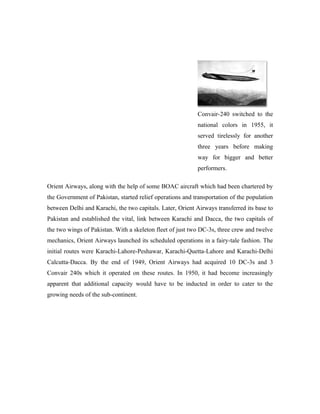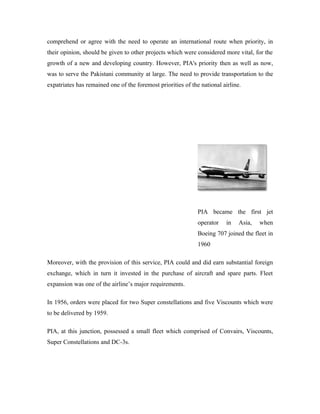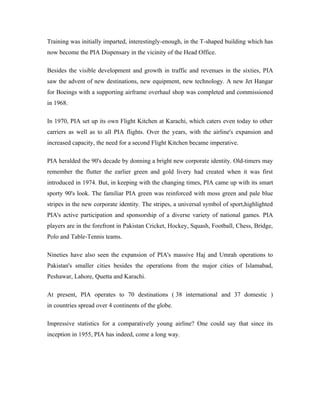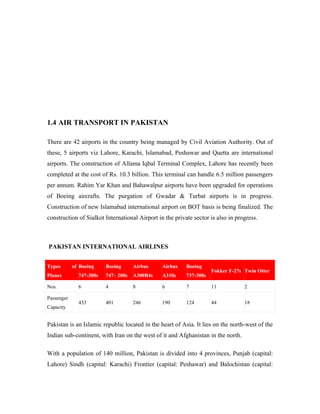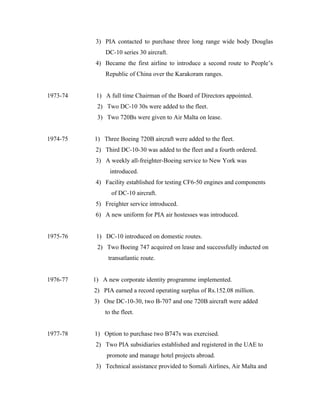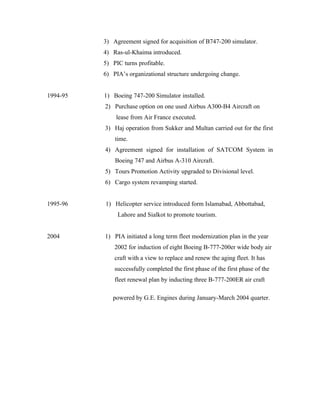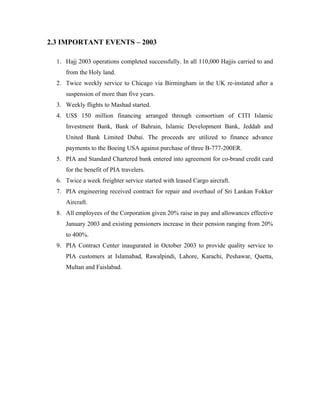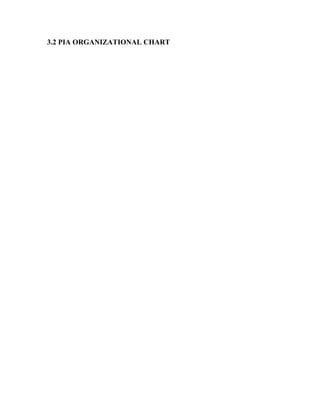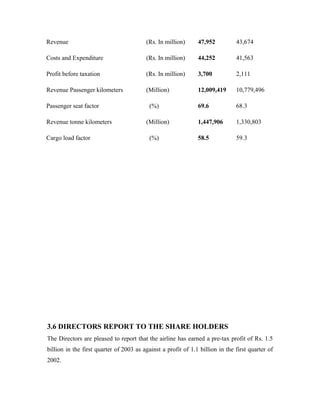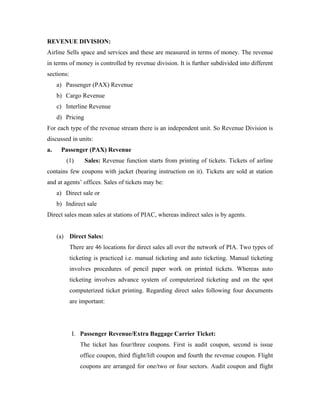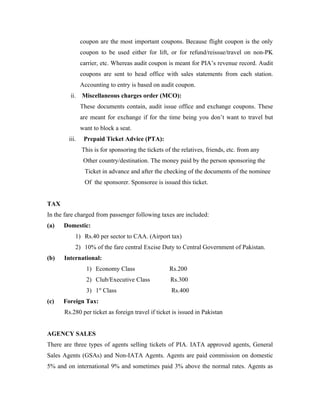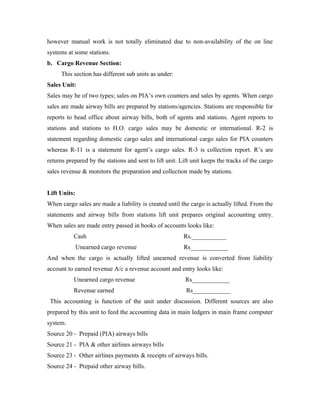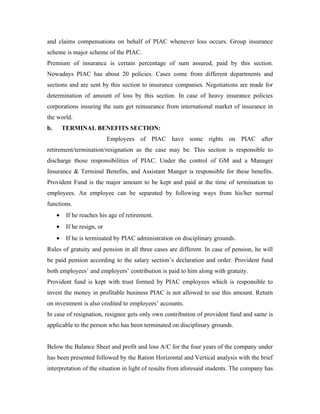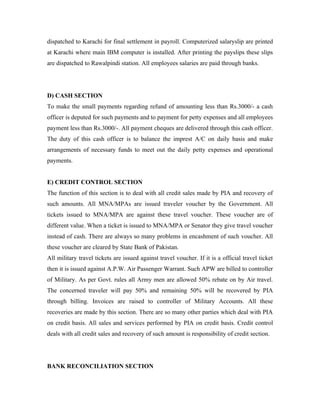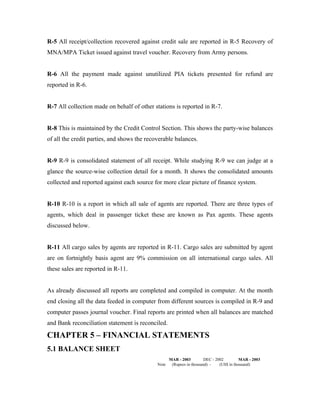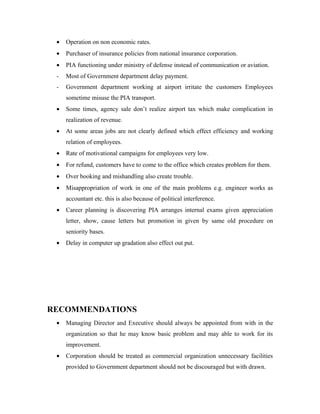Pia1
- 1. ACKNOWLEDGEMENT This project has been completed as a partial requirement of the MBA degree program from N.W.F.P Agricultural University Peshawar. My deepest gratitude is due towards my project advisor Mr. Saleem Rao and valuable suggestions by the course coordinator Mr. Muhammad Ashraf. I owe a lot to Mr. Abdul Rahim (Accounts Officer Rawalpindi) for guiding me during my visit to PIA Accounts Department Rawalpindi. I would also like to thank my friends especially Mr. Rahim, Mr. Umair, Mr. Waseem, Mr. Kashif and Mr. Amjad for providing me relevant information and material regarding this project. Saqib Rehman
- 2. EXECUTIVE SUMMARY The importance of Airline has been increased because of globalization where interaction of one country with other accomplished through Airlines. I have an honor to work for my Project work about Airlines, where I choose Pakistan Airlines, which is a dynamic organization providing service for last so many years. This project work looks on the consistent progress of PIA with an efficient and effective management. PIA introduced so many Jets, Boeings and many other Air transport tools by the passage of time to maintain the quality of Air travel more aggressive. Probably never has air transport been more important to the development of a new nation than in the case of Pakistan. In the days when Pakistan was still in the offing (June 1946) Mr. Mohammad Ali Jinnah, the Founder of the upcoming Nation, instructed Mr. M.A. Ispahani, a leading industrialist, to set up a national airline, on priority basis. With his singular vision and foresight, Mr. Jinnah had foreseen that with the formation of the two wings of Pakistan, separated by 1100 miles, a swift and efficient mode of transport was imperative. By the passage of time PIA has improved the quality of their services according to the demand of domestic and overseas, it also provides facilities with relaxation as the Air transport service needs. Due to its huge importance in this modern era, because the world has become a global village and each and every country of the world has to access each other through Air transport, so PIA is performing the same with up to date changes in the technology and management. This project work looks at the function of different department of PIA, particularly Finance Department that is recording the balance sheet, cash flows, income statements and all the financial data representing the profit and loss of the company. Though. PIA is not earning that much profit for last so many years but its consistent still with getting the target to maximize their profits. Finally PIA is also facing some problems and also there are some drawbacks, which should be solved for the better management of the organization. Political instability is a
- 3. huge problem in Pakistan that is affecting every organization directly and indirectly the economy. Other things that the management is not that much effective, so I must suggest that they improve their management function by applying management techniques. Employees should be paid incentives and fringe benefits that they can be work with deep devotion. At the end, PIA is the need of our nation so, it’s their responsibility to provide better service and up to date. That people cannot face any difficulty while traveling domestically and internationally.
- 4. MISSION STATEMENT As a symbol of National pride, Pakistan International must strive to be an airline of choice operating profitably on modern commercial concepts, capable of competing with the best in its entire International and Domestic markets consistently exceeding customer expectations. It should be a choice employer deploying modern technology in all spheres of its activates.
- 5. CHAPTER 1 – INTRODUCTION 1.1 BRIEF INTRODUCTION When Pakistan came into being on 14th August 1947 there was only one Airline in operation called “Orient Airways”. After some time two more airlines “Pakistan Air Limited” and “Crescent Airways” started commercial operation. None of these small Air Service Companies could succeed to cover the requirements of the Air Traffic of country. Ultimately two of these failed to continue their operation. In 1952 “Orient Airways” was the only operational company operating on domestic routes. The government and the people of Pakistan were sincerely struggling hard for development of their country with the aim to reach to the similar level of advancement as of other free nations of the world. Communication system is the basic requirement of country. So in 1955 the Government took an initiative and passed an ordinance to form an Air fleet under the name of Pakistan International Airlines (PIA) to meet the needs of domestic and international air traffic. PIA began operation on Karachi-Dhaka sector with three aircraft in 1955. Later PIA and Orient Airways, a private carrier, were merged to form PIAC (Pakistan International Airlines Company). Over the years PIA gradually expanded its network and is now serving 83 destinations in four continents.
- 6. 1.2 HISTORICAL BACKGROUND Probably never has air transport been more important to the development of a new nation than in the case of Pakistan. In the days when Pakistan was still in the offing (June 1946) Mr. Mohammad Ali Jinnah, the Founder of the upcoming Nation, instructed Mr. M.A. Ispahani, a leading industrialist, to set up a national airline, on priority basis. With his singular vision and foresight, Mr. Jinnah had foreseen that with the formation of the two wings of Pakistan, separated by 1100 miles, a swift and efficient mode of transport was imperative. Super Constellation L-1049 was the first to wear the colors of PIA The new airline was initially a pilot project, registered in Calcutta as Orient Airways Ltd., on 23rd October 1946. With Mr. A.M. Ispahani as the Chairman and Air Vice Marshal O.K. Carter as the General Manager of the new air carrier, an operating license was obtained in May 1947 with Calcutta as the base. Four Douglas DC-3s had been purchased from Tempo of Texas in February 1947 and operations first started on 4 June 1947. The designated route was Calcutta-Akyab-Rangoon, which also happened to be the first post-war international operation to be flown by an airline registered in India. Within two months of Orient Airways' operational beginnings, Pakistan was born. The birth of a new nation generated one of the largest transfers of population in the history of Mankind.
- 7. Convair-240 switched to the national colors in 1955, it served tirelessly for another three years before making way for bigger and better performers. Orient Airways, along with the help of some BOAC aircraft which had been chartered by the Government of Pakistan, started relief operations and transportation of the population between Delhi and Karachi, the two capitals. Later, Orient Airways transferred its base to Pakistan and established the vital, link between Karachi and Dacca, the two capitals of the two wings of Pakistan. With a skeleton fleet of just two DC-3s, three crew and twelve mechanics, Orient Airways launched its scheduled operations in a fairy-tale fashion. The initial routes were Karachi-Lahore-Peshawar, Karachi-Quetta-Lahore and Karachi-Delhi Calcutta-Dacca. By the end of 1949, Orient Airways had acquired 10 DC-3s and 3 Convair 240s which it operated on these routes. In 1950, it had become increasingly apparent that additional capacity would have to be inducted in order to cater to the growing needs of the sub-continent.
- 8. PIA - Convair – 240 Orient Airways was a privately owned company, with limited capital and resources. It could not be expected to grow and expand on its own. It was then that the Government of Pakistan decided to form a state-owned airline and invited Orient Airways to merge with it. The outcome of the merger was the birth of a new airline, named Pakistan International Airlines (PIA) on 11 March 1955. Viscount 815 inducted in 1958,it introduced the turbo props to the national Apart from transport activities, Orient Airways had established the nucleus of overhaul and maintenance facilities and acquired trained pilots, engineers and technicians that proved a great asset for PIA during its teething phase. The year 1955 also marked the inauguration of the fledgling airline's first scheduled international service - to the glittering, glitzy capital ciôy of U.K, London, via Cairo and Rome. At first, there was much criticism regarding this venture as the public could not
- 9. comprehend or agree with the need to operate an international route when priority, in their opinion, should be given to other projects which were considered more vital, for the growth of a new and developing country. However, PIA's priority then as well as now, was to serve the Pakistani community at large. The need to provide transportation to the expatriates has remained one of the foremost priorities of the national airline. PIA became the first jet operator in Asia, when Boeing 707 joined the fleet in 1960 Moreover, with the provision of this service, PIA could and did earn substantial foreign exchange, which in turn it invested in the purchase of aircraft and spare parts. Fleet expansion was one of the airline’s major requirements. In 1956, orders were placed for two Super constellations and five Viscounts which were to be delivered by 1959. PIA, at this junction, possessed a small fleet which comprised of Convairs, Viscounts, Super Constellations and DC-3s.
- 10. Boeing 720 joined PIA fleet in 1962, and broke all the London-Karachi international records on its delivery flight While Mr. M.A. Ispahani was the first Chairman of the new dynamic airline; it was the first Managing Director of PIA, Mr. Zafar-ul-Ahsan, who in his 4-year tenure, got the ball rolling and set the shape of things to come. The PIA Head Office building at Karachi airport, which houses all the major departments of the airline to date, was the brain-child of Mr. Zafar-ul- Ahsan. In fact, on his departure from the airline, the employees presented him with a silver replica of the building with the caption: "The House you Built".
- 11. Helicopter Sikorsky S61N joined In 1959, the Government of Pakistan appointed an Air Force Officer, Air Commodore Nur Khan (who later rose to the rank of Air Vice Marshal) as the Managing Director of PIA. With him at the helm of affairs, PIA took such a turn around in a short span of 6 years, that the airline gained the stature and status of one of the frontline carriers of the world. In aviation circles, this period has often been termed as the "golden years of PIA". Twin - Otter came to PIA in the year 1970 to help to improve the short distance. Expansion, growth, development were the key-words that the new management was committed to. In March 1960, PIA launched its first jet service (Boeing 707) on the London-Karachi-Dacca, route which later proved to be most successful. This service enabled PIA to become the first Asian Airline to operate a jet aircraft. A train-blazer, this success set the trend for PIA. In 1961, the airline took on the awesome task of initiating a cross-Atlantic service from Karachi to New York. By this time, PIA had placed orders for more new aircraft, which included Fokker F-27s, Boeing 720Bs and Sikorsky helicopters. Helicopter service in East Pakistan had gained momentum by 1962 and expanded to include Sylhet, Chittagong, Dacca, Comilla and Ishurdi. PIA's helicopter operations on a scheduled basis carried over 70,000 passengers during their first year. It was, at that time, regarded as equal to any other similar operation in the world. Unfortunately, due to two mishaps, the service was discontinued in 1966.
- 12. Twin - Otter In 1962, PIA attempted to set a new record and succeeded. On the London-Karachi sector, finding the upper winds forecast favourable, PIA set out to break the record for the fastest flight between London and Karachi. With representatives of FAI. (Federation Aeronautique International) on board to monitor the official timings, PIA completed the flight in 6 hours 43 min 51 sec, the fastest record which to this day remains unbroken. In 1964, PIA achieved another historic first, which to date is regarded as one of the milestones in the chequered history of the airline. On 29th April 1964, with a Boeing 720B, PIA had the distinction of becoming the first airline from a non-communist country to fly into the People’s Republic of China. The first service to China was from Karachi to Shanghai via Canton. In 1964-65, PIA expanded its fleet further with the addition of a fourth Boeing 720B and two Fokker
- 13. F-27s. Things were happening, PIA was developing. People were moving ahead with their plans, goals, ambitions for the national flag carrier. A collective pride, a joyous buoyancy seemed to pervade the PIA family. Riding high on the crest of success, PIA became a household name in Pakistan in the mid sixties. The war between India and Pakistan during 1965 served as a catalyst for PIA as the national airline had an additional role to perform. It played a major role in logistical support. PIA's Boeings, Super Constellations, and Viscounts operated special flights on behalf of the Armed Forces. The foresight of the Father of the Nation, Mr. Jinnah, that the air force would one day need a civil airline as a back-up had been evidenced. Later, in 1966, a system of feeder services linking eight new points in West Pakistan was introduced. By this time, the airline's Viscounts were proving inadequate due to the sizeable traffic growth and as such, had to be replaced by Tridents. The airline continued to grow, receiving two additional Fokker F-27s, two Boeing 707s and one Trident in the following year. This was also the time that the airline saw a change in the top slot. AVM Asghar Khan took over the reigns of PIA for a tenure of 3 years. A number of highpoints are relegated to this period. The most colourful, if not the most significant, happening for PIA was the introduction of a new air-hostesses' uniform designed by none other than the renowned French designer, Pierre Cardin. This, more than any other singular factor imprinted PIA's name on the international market. It took the aviation world by storm. It was an instant hit, both, at home and abroad. PIA's run for recording historic firsts was not yet over. Pakistan's first computer, an IBM1401, was installed by PIA in 1967. PIA's first Engine Overhaul Shop, located near the Head Office building, was also completed and commissioned around this time. The Ground Training School (GTS) now known as PIA Training Centre (PTC) was first conceived and developed sometime in 1961-62.
- 14. Training was initially imparted, interestingly-enough, in the T-shaped building which has now become the PIA Dispensary in the vicinity of the Head Office. Besides the visible development and growth in traffic and revenues in the sixties, PIA saw the advent of new destinations, new equipment, new technology. A new Jet Hangar for Boeings with a supporting airframe overhaul shop was completed and commissioned in 1968. In 1970, PIA set up its own Flight Kitchen at Karachi, which caters even today to other carriers as well as to all PIA flights. Over the years, with the airline's expansion and increased capacity, the need for a second Flight Kitchen became imperative. PIA heralded the 90's decade by donning a bright new corporate identity. Old-timers may remember the flutter the earlier green and gold livery had created when it was first introduced in 1974. But, in keeping with the changing times, PIA came up with its smart sporty 90's look. The familiar PIA green was reinforced with moss green and pale blue stripes in the new corporate identity. The stripes, a universal symbol of sport,highlighted PIA's active participation and sponsorship of a diverse variety of national games. PIA players are in the forefront in Pakistan Cricket, Hockey, Squash, Football, Chess, Bridge, Polo and Table-Tennis teams. Nineties have also seen the expansion of PIA's massive Haj and Umrah operations to Pakistan's smaller cities besides the operations from the major cities of Islamabad, Peshawar, Lahore, Quetta and Karachi. At present, PIA operates to 70 destinations ( 38 international and 37 domestic ) in countries spread over 4 continents of the globe. Impressive statistics for a comparatively young airline? One could say that since its inception in 1955, PIA has indeed, come a long way.
- 15. 1.3 OBJECTIVES OF PIAC According to PIAC Act 1956, following are main objectives of the corporation. I. To provide and further develop safe, efficient, adequate, economical and properly coordinated domestic as well as international air transport system. II. To operate any air-transport service or any flight by aircraft for a commercial or other purpose, and to carry out all forms of aerial work. III. To acquire, own, run, manage or participate in the running of management of, any hotel or business connected therewith. IV. To provide for the instruction and training in matters connected with aircraft or flight by aircraft of persons employed or desirous of being employed either by the corporation or by any other person. V. With the previous approval of the Federal Government, to promote any organization outside Pakistan for the purpose of engaging in any activity of a kind which the corporation has power t carry out. VI. To acquire, hold or dispose of any property, whether movable or immovable, or any air-transport undertaking. VII. To repair, overhaul, reconstruct assemble or recondition aircraft, vehicles or other machines and parts, accessories and instruments thereof or therefore and also to manufacture such parts, accessories and instruments whether the aircraft, vehicles or other machines are owned by the corporation or by any other person.
- 16. 1.4 AIR TRANSPORT IN PAKISTAN There are 42 airports in the country being managed by Civil Aviation Authority. Out of these, 5 airports viz Lahore, Karachi, Islamabad, Peshawar and Quetta are international airports. The construction of Allama Iqbal Terminal Complex, Lahore has recently been completed at the cost of Rs. 10.3 billion. This terminal can handle 6.5 million passengers per annum. Rahim Yar Khan and Bahawalpur airports have been upgraded for operations of Boeing aircrafts. The purgation of Gwadar & Turbat airports is in progress. Construction of new Islamabad international airport on BOT basis is being finalized. The construction of Sialkot International Airport in the private sector is also in progress. PAKISTAN INTERNATIONAL AIRLINES Types of Boeing Boeing Airbus Airbus Boeing Fokker F-27s Twin Otter Planes 747-300s 747– 200s A300B4s A310s 737-300s Nos. 6 4 8 6 7 11 2 Passenger 433 401 246 190 124 44 18 Capacity Pakistan is an Islamic republic located in the heart of Asia. It lies on the north-west of the Indian sub-continent, with Iran on the west of it and Afghanistan in the north. With a population of 140 million, Pakistan is divided into 4 provinces, Punjab (capital: Lahore) Sindh (capital: Karachi) Frontier (capital: Peshawar) and Balochistan (capital:
- 17. Quetta, Islamabad), the capital of Pakistan is a picturesque and well-planned city in the North. Pakistan is a land richly endowed with Nature's bounty-mighty mountains, ancient deserts, lush-green valleys and sparkling rivers. Pakistan International’s biggest asset is Pakistan, an attractive tourist wonderland. Wide- open spaces, lush green fields, the world's largest collection of limitless mountain chains and peaks, lakes and rivers on the same mammoth scale, Pakistan's natural attractions have few equals. For the world's people, Pakistan presents a totally different face of Mother Nature. An off-beat, exciting place, coupled with the traditional warm hospitality of its friendly people. As jaded tourists worldwide hunt for new settings and experiences, PIA has been playing the role of linking places and bringing people closer, from the four continents of the world. PIA has played a pivotal role in opening up the county's natural and historical riches by air linking then with the national and international mainstream. When PIA wings to isolated scenic spots such as Gilgit, Skardu, Swat or any of the other over two dozen colourful domestic destinations, the national airline is involved in the business of meshing its international goals and targets along with its national responsibilities. Thus, PIA assists in putting in motion a tourism nucleus, whereby a feast of sights and sounds, of action and entertainment is prepared for the tourist in search of an off-beat adventure. The national carrier has consistently, over the last 4 decades, played an active role in the development and promotion of tourism in Pakistan. It is all geared up to give the tourists not just good value for their money but also make their trips to this charming country truly memorable. PIA CARGO NETWORK
- 18. Besides country wide domestic network, cargo is directly serving 40 international destinations round the globe, while rest of the world is being served through interline carriage beyond PK points. PIA’s average cargo revenue is around US dollar 82 million per year, with system uplift of approx. 75,000 tons, on an average system wide yield of US dollar 1.10 per kilogram. PIA,s network is spread over internationally defined freedoms as mentioned in the chart below. Type of Plane No. of Pallets Weight in tons Boeing 747-300s 7 15-22 Boeing 747-200s 5 10-15 Airbus A 310s 3 10.5 Airbus A 310s 3 10.5 Boeing 737-300s - 2 Boeing Combi 13 50 A 300 Freighter 22 40 FREEDOM WISE PERFORMANCE AVERAGE TONS UPLIFT PER YEAR
- 19. AUTOMATION During the last decade PIA has systematically automated its cargo reservations, Warehouse and terminals at all major stations. The FAST-IV system through SITA was installed and at the moment almost 80% of PIA cargo activities are automated. The use of this Electronic system has improved the service standards and brought the airline in with other developed carriers. SHAHEEN AIR INTERNATIONAL Shaheen Air international in the 2nd National carrier after PIA, Incorporated as a public limited company. It started commercial operation in December 1992. This airline is run and managed by the retired personnel of Pakistan Air Force. The fleet of Shaheen International Airlines consists of 4 planes as under:- Types of Planes Yak 42 TU154 Nos. 2 2 Passenger Capacity 114 154 Shaheen Airlines undertakes domestic as well as international flights. Its international destinations are Abu Dhabi, Dubai and Doha from major cities of Pakistan, i.e. Islamabad, Lahore and Peshawar. Cargo is handled through an independent agency, Shaheen Airport Cargo Services AERO ASIA Aero Asia is being operated in the private sector by Tabani Corporations which comes into operations in April 1993. The fleet consists of the following planes:
- 20. Types of Planes Boeing 737 DC 9 Mac Nos. 2 2 1 Passenger Capacity 120 120 117 CHAPTER 2 – EVENTS 2.1 FATAL EVENTS SINCE 1970 The following events are those involving at least one passenger death where the aircraft flight had a direct or indirect role. Excluded would be events where the only passengers killed were stowaways, hijackers, or saboteurs. 1. 5 August 1970; Pakistan International Airlines F27; Islamabad, Pakistan: The aircraft entered a steep dive and crashed about three minutes after a night takeoff in poor weather. All four crew members and 26 passengers were killed. 2. 31 December 1970; Pakistan International Airlines F27; East Pakistan: The aircraft lost altitude and impacted about 300 feet (90 meters) short of the runway. Seven of the 31 passengers were killed. 3. 8 December 1972; Pakistan International Airlines F27; near Jalot, Pakistan: The aircraft struck high ground during a flight under deteriorating weather conditions. All five crew members and 28 passengers were killed. 4. 26 November 1979; Pakistan International Airlines 707-300; near Jeddah, Saudi Arabia: A fire developed in the rear of the passenger cabin about 18 minutes after takeoff. During the emergency air turn back, the crew was incapacitated by smoke and fumes and the aircraft crashed about 87 miles (140 km) from the airport. The source of the fire was not determined, but the most probable source was the ignition of fuel from a portable stove carried by a passenger. All 11 crew members and 145 passengers were killed. 5. 23 October 1986; Pakistan International Airlines F27; near Peshawar, Pakistan: The aircraft struck the ground about 2.5 miles (4 km) short of the runway during a night approach. Six of the seven crew members and 7 of the 47 passengers were killed.
- 21. 6. 25 August 1989; Pakistan International Airlines F27; near Jalot, Pakistan: The aircraft was reported missing after a flight through mountain valleys and poor weather. All five crew members and 49 passengers were presumed killed. 7. 28 September 1992; Pakistan International Airlines A300B4; near Katmandu, Nepal: The crew was flying the aircraft was flying an approach about 1600 feet (1000 meters) lower than planned when the aircraft collided with high ground. The event happened in daylight and with cloud shrouding the mountains. All 12 crew and 155 passengers were killed.
- 22. 2.2 YEAR WISE PROGRESSIVE EVENTS 1954 1) Pakistan International Airlines established. 2) PIA’s first Super-Constellation (AP-AFQ) registered on April 24, 1954. 3) PIA started its regular service from May 10, 1954. 4) Direct service introduced between West and East Pakistan (now Bangladesh). 1955 1) Pakistan international Airlines Corporation formed with merger of PIA and Orient Airways. 2) PIA entered the world of international aviation with service from Karachi to London via Cairo and Rome. 1956 1) Engineering base takes shape. First Super-constellation engine over hauled at PIA’s own shop. Extensive training programmes launched. 2) Orders placed for two Lockheed Super-h Constellations and three- with option of five Vickers Viscount turbo-prop airliners. 1957 1) PIA starts making a profit. Until about the middle of 1956, it had been running at a loss of about Rs.10 million annually. 1958-59 1) First tow Viscounts began operating and traffic increased on all domestic and European routes. 2) PIA started modernizing its fleet by replacing the Convairs with turbo- prop Viscount aircraft. 1959-60 1) Boeing 707-320 “International” introduced on the London route. 2) Became the first Asian airline to operate a jet (by leasing one from Pan American World Airways). 1960-61 1) First three of five Fokker F-27s received and order placed for three
- 23. Boeing 720B jet aircraft. 2) Karachi-New York service inaugurated. 1961-62 1) Operating revenues increased by 39% over previous year. 87.7% of all flights operated on time or within 15 minutes of schedule. 2) First Boeing 720B received in January. 3) 1379 students completed 2,28,268 student-hours in PIA’s integrated Ground Training School. 1962-63 1) Integration of Boeing 720B fleet completed. Order for three Sikorsky S6 in helicopters placed. 2) Boeing 720B introduced between the two wings of the country. 1963-64 1) Became the first non-communist airline to fly to the People’s Republic of China, and to operate a service between Asia and Europe via Moscow. 2) Commercial, unsubsidized helicopter service operated through East Pakistan (now Bangladesh). 1964-65 1) Fourth Boeing 720B aircraft arrived. Two more Fokker F-27 aircraft were received just after the close of the year. 2) Record operating surplus of Rs.49.22 million 54.71% of paid up capital was made. 1965-66 1) A system of feeder services linking eight new places was introduced in West Pakistan. 2) Pierre Carden uniform for air hostesses introduced. 1966-67 1) An IBM 1401, the first computer in Pakistan, was installed in PIA. 2) Engine Overhaul Shop was commissioned and completed. 3) More aircraft, two Boeing 707-340Cs, one Trident 1E and two F-27,
- 24. were added to the fleet. 3) PIA Air Academy started functioning. 1967-68 1) One more Fokker F-27 and one Boeing 707 received. 2) First batch of PIA trainee-pilots completed their training from PIA flying school and received Commercial Pilot’s License. 3) A new jet Hanger for Boeings and a supporting airframe overhaul shop/commissioned and completed. 1968-69 1) Fourth Boeing 707 received. 2) Order placed for a Boeing 707 flight simulator. 3) Passengers carried on domestic services crossed the million mark. 1969-1970 1) Agreement signed for maintenance of Air Ceylon’s Trident 1E aircraft at PIA workshop. Engineering services also extended to Royal Nepal Airlines Corporation for the overhaul of Fokker Aircraft. 2) Agreement signed for the sale of Tridents To China. 1970-71 1) Order for one more F-27 placed. 2) Flight Kitchen at Karachi inaugurated. 1971-72 1) Transatlantic service resumed. 2) Close circuit television system installed at Karachi Airport. 3) Agreement signed with LAA for domestic operation in Libya. 4) Agreement signed with the Yugoslav airline JAT for lease of three Boeing 707 aircraft. 1972-73 1) Terminal facilities at Islamabad and Karachi expanded. 2) Management agreement signed with Air Malta under which PIA seconded a Management team to Malta.
- 25. 3) PIA contacted to purchase three long range wide body Douglas DC-10 series 30 aircraft. 4) Became the first airline to introduce a second route to People’s Republic of China over the Karakoram ranges. 1973-74 1) A full time Chairman of the Board of Directors appointed. 2) Two DC-10 30s were added to the fleet. 3) Two 720Bs were given to Air Malta on lease. 1974-75 1) Three Boeing 720B aircraft were added to the fleet. 2) Third DC-10-30 was added to the fleet and a fourth ordered. 3) A weekly all-freighter-Boeing service to New York was introduced. 4) Facility established for testing CF6-50 engines and components of DC-10 aircraft. 5) Freighter service introduced. 6) A new uniform for PIA air hostesses was introduced. 1975-76 1) DC-10 introduced on domestic routes. 2) Two Boeing 747 acquired on lease and successfully inducted on transatlantic route. 1976-77 1) A new corporate identity programme implemented. 2) PIA earned a record operating surplus of Rs.152.08 million. 3) One DC-10-30, two B-707 and one 720B aircraft were added to the fleet. 1977-78 1) Option to purchase two B747s was exercised. 2) Two PIA subsidiaries established and registered in the UAE to promote and manage hotel projects abroad. 3) Technical assistance provided to Somali Airlines, Air Malta and
- 26. Yemen Airways. 1978-79 1) Induction of two additional Boeing 747s and four A300 aircraft. 2) Cut-over of domestic stations to in-house computerized reservations system. REPAK. 3) Opening of Air Cargo Centre at Karachi Airport. 4) Establishment of new downtown sales office. 1979-1980 1) Wide body hangar and related workshop commissioned. 2) International stations cut-over to the in-house computerized reservations system. 1980-81 1) International stations cut-over to the in-house computerized reservations system. 2) New flight control system opened at Karachi Airport. 1981-82 1) Weekly service to Abu Dhabi and Dubai from Peshawar inaugurated. 2) PIA was rated as the leading and the most efficient airline for the year 1981 Haj operation. 3) Duty Free Shopping Complex inaugurated at Karachi Airport. 1982-83 1) PIA earned an all-time high operating surplus of Rs.441.0 million 2) Another DC10, Airbus and 707 were added to the fleet. 3) First ever “C and D” Checks were carried out on Boeing 747 and DC-10 respectively. 4) PIA introduced “Direct Inward Dialing” telephone facility first time in the country. 5) Mini-Micro computers installed in PIA Head Office. 1983-84 1) Automation of budget, finance, revenue and other important
- 27. areas introduced. 2) Islamabad-New York flight via Istanbul inaugurated. 3) Night Coach Services between Lahore Karachi and Islamabad and Lahore introduced. 4) Foundation of PIA Township laid at Karachi Airport for the employees. 5) Extension and modernization laid at Karachi Airport for the employees. 6) Extension and modernization of the PIA Flight Kitchen undertaken. 1984-85 1) PIA set up first ever planetarium of Pakistan at Karachi. 2) PIA introduced Feeder service in the country. 3) Five Boeing 737-300 aircraft inducted into the PIA fleet. 4) PIA’s revenue, for the first time, exceeded the Rs.10,000 million mark. 1985-86 1) Introduced of “Sohni” Executive Class on all PIA B747 aircraft on international flights. 2) New uniform for airhostesses introduced. 3) Fourth flight introduced to New York. 1986-87 1) PIA started flights to Male. 2) Fifth weekly flight to New York introduced. 3) PIA introduced auto-ticketing facility. 1987-88 1) Flight Kitchen at Islamabad inaugurated. 2) PIA hosted first international course on Civil Air Transport. 3) PIA inaugurated services to Toronto. 4) Sixth weekly flight to New York introduced. 5) Up gradation of China and Singapore operation to Boeing 747.
- 28. 1988-89 1) Introduction of Twin Otter operation to Muzaffarabad and Rawalakot. 1989-90 1) Two women pilots were inducted in PIA, for the first time in Pakistan’s history to operate passenger flights. 2) PIA introduced the first ever direct Haj flights from Lahore to Jeddah. 1990-91 1) PIA introduced a new international flight, Peshawar-Jeddah via Lahore. 2) A direct Lahore-Bangkok flight introduced. 3) Advanced Boarding facility introduced. 4) HI-Tech A310-300 aircraft inducted into PIA fleet. 5) PIA’s new corporate identity introduced. 1991-92 1) PIA flight to Tashkent introduced. 2) Peshawar added as fourth point for Haj operations. 3) Agreements signed to link PIA reservations with Sabre, Galileo and Amdeus-Global Distribution System. 4) Achieved record revenue of Rs.20 billion and unprecedented operating surplus of Rs.1.58 billion. 1992-93 1) PIA introduced flights to Zurich. 2) Flight to Sharjah resumed. 3) Direct flights between Islamabad and Singapore and Lahore and Kuwait introduced. A300 B4 Simulator installed. 1993-94 1) Flights to Jakarta, Almaty, Ashkabad, Baku, Al-Ain, Fujairah and Parachinar introduced. 2) Air Safari flights introduced.
- 29. 3) Agreement signed for acquisition of B747-200 simulator. 4) Ras-ul-Khaima introduced. 5) PIC turns profitable. 6) PIA’s organizational structure undergoing change. 1994-95 1) Boeing 747-200 Simulator installed. 2) Purchase option on one used Airbus A300-B4 Aircraft on lease from Air France executed. 3) Haj operation from Sukker and Multan carried out for the first time. 4) Agreement signed for installation of SATCOM System in Boeing 747 and Airbus A-310 Aircraft. 5) Tours Promotion Activity upgraded to Divisional level. 6) Cargo system revamping started. 1995-96 1) Helicopter service introduced form Islamabad, Abbottabad, Lahore and Sialkot to promote tourism. 2004 1) PIA initiated a long term fleet modernization plan in the year 2002 for induction of eight Boeing B-777-200er wide body air craft with a view to replace and renew the aging fleet. It has successfully completed the first phase of the first phase of the fleet renewal plan by inducting three B-777-200ER air craft powered by G.E. Engines during January-March 2004 quarter.
- 30. 2.3 IMPORTANT EVENTS – 2003 1. Hajj 2003 operations completed successfully. In all 110,000 Hajjis carried to and from the Holy land. 2. Twice weekly service to Chicago via Birmingham in the UK re-instated after a suspension of more than five years. 3. Weekly flights to Mashad started. 4. US$ 150 million financing arranged through consortium of CITI Islamic Investment Bank, Bank of Bahrain, Islamic Development Bank, Jeddah and United Bank Limited Dubai. The proceeds are utilized to finance advance payments to the Boeing USA against purchase of three B-777-200ER. 5. PIA and Standard Chartered bank entered into agreement for co-brand credit card for the benefit of PIA travelers. 6. Twice a week freighter service started with leased Cargo aircraft. 7. PIA engineering received contract for repair and overhaul of Sri Lankan Fokker Aircraft. 8. All employees of the Corporation given 20% raise in pay and allowances effective January 2003 and existing pensioners increase in their pension ranging from 20% to 400%. 9. PIA Contract Center inaugurated in October 2003 to provide quality service to PIA customers at Islamabad, Rawalpindi, Lahore, Karachi, Peshawar, Quetta, Multan and Faislabad.
- 31. CHAPTER 3 - ORGANIZATION 3.1 ORGANIZATION Corporation (PIAC) has been divided into thirteen departments as shown in organizational chart. PIA is one of the biggest commercial organizations in our country and has worldwide operation. The corporation has network of flights around the globe. To control worldwide operation, there is a department meant for overall management of PIAC. Administration Department consists of seven divisions and units. Each department is headed by a Director, each Division in headed by GM, each section by Manager and subsections and units are controlled by assistant managers.
- 32. 3.2 PIA ORGANIZATIONAL CHART
- 33. 3.3 NUMBER OF EMPLOYEES As we know PIA is one of the biggest commercial organizations in our country and has worldwide operations. To achieve the objectives PIA needs a trained staff. So total number of regular employees as on DECEMBER 01, 2003 were 19,128, excluding PRE- ENGINEERING DEPARTMENT which were 652. PERSONNEL DEC 01, 2003 1. Captains / Co-Pilots / Cadet 536 Pilots 2. Aircraft Engineers 687 3. Flight Engineers 103 4. Female Cabin Crew 1015 5. Male Cabin Crew 802 Total Number of Regular Employees 19,128 (Excluding Pre-Engg deptt= 652) 3.4 INITIATIVES UNDERTAKEN SPEEDEX In July 2003, the airline launched SPEEDEX PIA`s door-to-door Courier Service. This service was initially introduced in Karachi, Islamabad and Lahore and in the second
- 34. phase has been expanded to 12 other cities of Pakistan. In addition, a Franchise program has also been launched with an aim to proliferate this highly specialized market. CONTACT CENTER As PIA strives to become the airline of choice exceeding customer expectations, it is developing modern technology in all spheres of its activities. One such exemplary effort is the PIAC Contact center which is a single which is a single window to reach PIAC, for access to information related to support, products, and customer inquiries. FINANCIAL PERFORMANCE The airline`s total revenue increased by 9.8 percent over last year to Rs. 47.952 billion (2002: Rs. 43.674 billion). EMPLOYEES WELFARE The restructuring strategy of PIA has started to pay off with the measures initiated by the management since June 2001. In recognition of the contribution of its employees in the turnaround, a salary increase of 20 percent has been awarded. The airline has also taken cognizance of the plight of its retired employees who did not receive increase in in their pension since 1992 by raising their pension between 20% to 400%. TFCs OVER SUBSCRIBED BY 40 % The airline launched Term Finance Certificates (TFCs) for Rs. 15.14 billion in February 2003.The issue was the largest in the history of Pakistan`s financial market. Despite the size , the issue was over-subscribed to the extent of 40 percent showing confidence in the policies followed by the management. The Corporation has utilized the money raised through TFCs to pay off bridge financing of Rs. 7.73 billion borrowed earlier, payment of overdue liabilities of emploee funds and financing part of the acquisition cost of Boeing 777-200. RENEGOTIATION OF MARK-UP RATES To benefit from the change in the interest rate environment, the airline negotiated substantial reduction in the mark-up rate on the redeemable capital with the local banks.
- 35. The airline also succeeded in obtaining a reduction in the rates on vehicles leased from various banks and leasing companies. AUTOMATION After thorough industry survey, a state-of-the-art Sabre Revenue Accounting System has been selected for automation of the entire revenue accounting process of the Corporation. This shall enable the Corporation to have a most up-to-date Management Information System for setting up and developing marketing strategies. The airline is considering a new inventory management system to streamline procurement and save on inventory costs. FLEET RENEWAL The Corporation initiated a long term fleet modernization plan in the year 2002 for induction of eight Boeing B-777-200ER wide body aircraft with a view to replace an renew the aging fleet. It has successfully completed the first phase of the fleet renewal plan by inducting three B-777-200-ER aircraft powered by G.E. Engines during January- March 2004 quarter. Further during 2003, the Corporation entered into a contract with Airbus Industry for lease of six used A-310 aircraft with a purchase option.The first of the six aircraft was delivered in December 2003 and the remaining five aircraft will be delivered in the first half of year 2004.The induction of Boeing-777-200ER and A-310 would enable the airline to offer increased capacity. Plans are also underway to replace Fokker fleet with a newer Turboprop aircraft in 2004. The above fleet changes will reduce the airlines fleet age from 23 years in December 2003 to 12 years by end of 2004. TRAINING The engineering department launched an intensive training program and 600 engineering personnel were trained for B-777/A-310 aircraft. 3.5 HIGHLIGHTS 2003 2002
- 36. Revenue (Rs. In million) 47,952 43,674 Costs and Expenditure (Rs. In million) 44,252 41,563 Profit before taxation (Rs. In million) 3,700 2,111 Revenue Passenger kilometers (Million) 12,009,419 10,779,496 Passenger seat factor (%) 69.6 68.3 Revenue tonne kilometers (Million) 1,447,906 1,330,803 Cargo load factor (%) 58.5 59.3 3.6 DIRECTORS REPORT TO THE SHARE HOLDERS The Directors are pleased to report that the airline has earned a pre-tax profit of Rs. 1.5 billion in the first quarter of 2003 as against a profit of 1.1 billion in the first quarter of 2002.
- 37. Total revenue for the quarter amount 13.05 billion as against Rs. 1197 billion in the corresponding quarter showing an over all increase of 9% over the same period last year. Expenses for the current quarter amounting to Rs. 11.07 billion indicate an increase of 8% over Rs. 10.2 billion expenditure last year. This is mainly due to increase in fuel prices in the international markets and an ad hoc provision for increase in employees' salaries and allowances. MARKET DEVELOPMENT In the first quarter the airline has increased passenger capacity by 10% over same period last year. In the international markets passenger capacity has been increased by 6% and domestic markets by 8%. Capacity for Hajjis for Hajj 2003. This year airline was successful in operating Hajj flights for 108,000 Hajjis as compared to 91,000 in 2002. The airline achieved passenger growth of 7% in the first quarter of 2003 over the same period last year. Increase in the international as well domestic markets excluding Hajj was up to the extent of 4%. The airline has also been able to float excess cargo capacity and increase its utilization. Cargo capacity was increased by 9 % whereas its utilization was 23% over last year the same quarter. ISSUE OF TERM FINANCE CERTIFICATES (TFCs) As reported in the Annual Report 2002 the airline launched Term Finance Certificates (TFCs) for Rs. 15.14 billion in February 2003. The issue was the largest in the history of Pakistan financial market. Despite the size, the issue was over subscribed up to the extent of 40% showing confidence in the policies followed by the airline Management. The airline has utilized the money wised through TFCs to pay off bridge financing of Rs. 7.73 billion borrowed earlier. The airline has nlso liquidated its liabilities towards employees fund over due creditors amounting to Rs. 4.27 billion. BOEING AGREEMENT
- 38. The 777-induction program is proceeding as per schedule as the first aircraft is planned to be delivered to the airline in the middle of January 2004. To meet pre-delivery payments to the Boeing, the airline has negotiated a bridge loan of US$ 150 million from Citibank syndicate, which will be liquidated on receipt of Exlm Bank loan on delivery of aircraft. The outstanding financing facility of US$ 85 million obtained last year will also be repaired out of this loan. CHAPTER 4 – FINANCE DEPARTMENT 4.1 ORGANIZATIONAL CHART OF FINANACE DEPARTMENT
- 39. 4.2 DIVISIONS OF FINANCE DEPARTMENT Out of the nine divisions in the department “Revenue Division” is the most important division. Some of the important division/sections are described below in detail.
- 40. REVENUE DIVISION: Airline Sells space and services and these are measured in terms of money. The revenue in terms of money is controlled by revenue division. It is further subdivided into different sections: a) Passenger (PAX) Revenue b) Cargo Revenue c) Interline Revenue d) Pricing For each type of the revenue stream there is an independent unit. So Revenue Division is discussed in units: a. Passenger (PAX) Revenue (1) Sales: Revenue function starts from printing of tickets. Tickets of airline contains few coupons with jacket (bearing instruction on it). Tickets are sold at station and at agents’ offices. Sales of tickets may be: a) Direct sale or b) Indirect sale Direct sales mean sales at stations of PIAC, whereas indirect sales is by agents. (a) Direct Sales: There are 46 locations for direct sales all over the network of PIA. Two types of ticketing is practiced i.e. manual ticketing and auto ticketing. Manual ticketing involves procedures of pencil paper work on printed tickets. Whereas auto ticketing involves advance system of computerized ticketing and on the spot computerized ticket printing. Regarding direct sales following four documents are important: I. Passenger Revenue/Extra Baggage Carrier Ticket: The ticket has four/three coupons. First is audit coupon, second is issue office coupon, third flight/lift coupon and fourth the revenue coupon. Flight coupons are arranged for one/two or four sectors. Audit coupon and flight
- 41. coupon are the most important coupons. Because flight coupon is the only coupon to be used either for lift, or for refund/reissue/travel on non-PK carrier, etc. Whereas audit coupon is meant for PIA’s revenue record. Audit coupons are sent to head office with sales statements from each station. Accounting to entry is based on audit coupon. ii. Miscellaneous charges order (MCO): These documents contain, audit issue office and exchange coupons. These are meant for exchange if for the time being you don’t want to travel but want to block a seat. iii. Prepaid Ticket Advice (PTA): This is for sponsoring the tickets of the relatives, friends, etc. from any Other country/destination. The money paid by the person sponsoring the Ticket in advance and after the checking of the documents of the nominee Of the sponsorer. Sponsoree is issued this ticket. TAX In the fare charged from passenger following taxes are included: (a) Domestic: 1) Rs.40 per sector to CAA. (Airport tax) 2) 10% of the fare central Excise Duty to Central Government of Pakistan. (b) International: 1) Economy Class Rs.200 2) Club/Executive Class Rs.300 3) 1st Class Rs.400 (c) Foreign Tax: Rs.280 per ticket as foreign travel if ticket is issued in Pakistan AGENCY SALES There are three types of agents selling tickets of PIA. IATA approved agents, General Sales Agents (GSAs) and Non-IATA Agents. Agents are paid commission on domestic 5% and on international 9% and sometimes paid 3% above the normal rates. Agents as
- 42. well as stations are required to submit the sales statements. These may be daily/weekly/monthly as the case may be. Life Unit: This unit is further subdivided into “life control” and “life automation” sub units. Domestic ticket is directly treated as revenue but international tickets are treated as “Unearned Revenue” which is liability. Unearned revenue is treated as earned when the passengers are actually lifted. Lift unit is concerned with checking of flight tickets according to schedules of flights for the passengers actually lifted. Domestic tickets are treated as revenue directly because experience tells that people on domestic routes rarely miss travel. But to international due to non completion of document people miss the flights and refunds occur unusually. International flights are 20% to 30% over booked for covering the seats of passengers not traveling. Domestic coupons are directly recorded in accounts by sales unit but international tickets coupons are fed in computer for matching of list with lifted passengers record. No matter when the ticket was sold and where it was sold. This unit gets all required documents from sales unit and that gets these from stations concerned. Refund Unit: Persons who do not report 72 hours before the flight the seat is automatically canceled. In case of international tickets the unused tickets are fully refunded. Jacket covering the coupons of the ticket bears instructions and procedure of cancellation charges with specified rates. Accounting Units: Disks/information received from all stations, sometimes enables this unit to monitor accounting and prepare floppies and transmit them to the main frame. In PIAC accounting is fully automated and computerized. Few stations have on line systems too
- 43. however manual work is not totally eliminated due to non-availability of the on line systems at some stations. b. Cargo Revenue Section: This section has different sub units as under: Sales Unit: Sales may be of two types; sales on PIA’s own counters and sales by agents. When cargo sales are made airway bills are prepared by stations/agencies. Stations are responsible for reports to head office about airway bills, both of agents and stations. Agent reports to stations and stations to H.O. cargo sales may be domestic or international. R-2 is statement regarding domestic cargo sales and international cargo sales for PIA counters whereas R-11 is a statement for agent’s cargo sales. R-3 is collection report. R’s are returns prepared by the stations and sent to lift unit. Lift unit keeps the tracks of the cargo sales revenue & monitors the preparation and collection made by stations. Lift Units: When cargo sales are made a liability is created until the cargo is actually lifted. From the statements and airway bills from stations lift unit prepares original accounting entry. When sales are made entry passed in books of accounts looks like: Cash Rs.___________ Unearned cargo revenue Rs____________ And when the cargo is actually lifted unearned revenue is converted from liability account to earned revenue A/c a revenue account and entry looks like: Unearned cargo revenue Rs____________ Revenue earned Rs____________ This accounting is function of the unit under discussion. Different sources are also prepared by this unit to feed the accounting data in main ledgers in main frame computer system. Source 20 - Prepaid (PIA) airways bills Source 21 - PIA & other airlines airways bills Source 23 - Other airlines payments & receipts of airways bills. Source 24 - Prepaid other airway bills.
- 44. These sources are prepaid by lift section and sent to DPC. This unit has been divided into two more cells one in mail and other miscellaneous. Mail Cell It is concerned with revenues and accounting of the revenues from mail carried by PIA carriers. Every year there was dealing and carrying of mail at national and international levels through Postmaster General Pakistan but now PIA is independently dealing with agencies. Mail may be of following types: 1) Domestic mail 2) International mail. PIA is earning about Rs.12 crore revenue yearly from all types of mails carried at national and international levels. Instead of cargo airway bills this cell is concerned with mail way bills on the basis of which accounting is done. Miscellaneous Revenue This cell deals with return R-4 which consists of handling charges (credit & cash) transactions and refunds etc. through cash clearance account and total advances account. Cash receipts and invoices and disks along with lists are attached R-4. data is arranged, checked and sent to DPC in a form to be fed in computer system. Stations send return’s summary on monthly basis to Head Office. c. International Revenue Section: All airlines render services and these are measured in terms of money. Revenue division is responsible to keep the tracks of all the revenue. Interline revenue has two aspects: (1) Receivable – When ticket is purchased by passenger from any other airline but lifted by PIA. (2) Payable – When ticket is purchased by passengers from PIA but are lifted by some other carrier. These transactions are settled through IATA clearance house. IATA clearance house has its member airlines, these airlines have their accounts with IATA. But non-IATA member
- 45. airlines are dealt according to the standing agreements with them. As IATA regulates the airline industry in the world most of the settlements are through IATA. Sometimes revenue is divided according to sectors carried. These types of the settlement are made on the basis of mileage. This is called proration. For settlement there are three currencies in which payments are receipts are made. • European currency • US Dollar; and • Pound sterling d. Pricing: This section of the revenue division was established in 1975. It acts as regulating authority of the airline. According to IATA rules approved fare written on the face of the tickets should be charged as that fare is approved. But the airlines undercut their fare specially in other than the base country. This section monitors these underground unethical violations of the IATA rules. When other airlines undercut fares and PIA feels that it must also undercut, the station managers prepares proposals about fare expected to be charged and sends these proposals to marketing department. Marketing department analysis the proposals and approve them after comparing with last year’s figures. Final approval is made by “director sales”. Functions of this section are to: • Monitor the sales and undercutting. • Provide funds through secret accounts. • Check whether the undercutting is made according to approval or not. • Do accounting for this commission item. • Make reconciliation of secret accounts, with undercutting and special incentive commission. • Account with statement received from stations and GSAs.
- 46. IATA keeps regular check on undercut, collect evidences from people passengers, explore the records of suspected stations and agents but still undercut is rapidly growing. FINANCIAL SERVICES DIVISION PAYROLL SECTION: Financial Services Division consists of three sections: • Payroll/taxes section • Disbursement section; and • Other departmental finance sections Here, we are concerned with payroll/taxes section which is headed by manager. Payroll/taxes section has further been divided into two units. a. Salary & taxes unit b. Reimbursement and foreign salaries unit a. Salary/Taxes Unit: Domestic salary and taxes to be deducted at source are the responsibility of this unit. Disbursement of the salaries is made through banks this function is watched by unit under discussion. Attendance account of each employee is kept by computer system. Casual leaves, sick leaves, medical leaves, accident leave, and others are recorded in this account and if employee exceeds the extended limits of leave, the deductions are made from the salary. Allowances/funds including House Rent allowance, Provident fund, medical allowance, qualification allowance and others are calculated on the basis of the previous months recorded. Salary preparation system is computerized and payments are made by cheques through employees’ bank accounts. b. Reimbursement unit: All expensed and payments made by the employees on behalf of the corporation are reimbursed and paid back to them. Besides this travel, entertainment, taxi fare, care
- 47. allowance, etc. are also paid to employees. Following are the sources for recording all information regarding on employees’ salary. Source 50 sent by manager employment contains basic information about employees. Source 51 Prepared by this section to make deduction from the salary. Source 52 any single change in the salary. It is called “salary structure change adjustment advice”. Source 53 For miscellaneous recoveries of loans and advances this source is not concerned with salary but with loans and advances. Source 54 Master Taps Statistical Data Change Advice. Source 55 “Master Tape Amount Adjustment/change advice”. Regarding salary/loans refund. Source 56 Salary structure change adjustment advice for multiple changes on multiple date in the salary and its structure. Source 57 Attendance Form. Source 58 No more in use. Source 59 Termination advice. TAXES: Taxes are under control of the assistant manager salary and taxes, who is responsible to deduct tax at source form taxable salaries of the employees according to current tax rates extended by Federal Government. INSURANCE AND TERMINAL BENEFITS This division is headed by a qualified GM. The division consists of: a. Insurance b. Terminal Benefits. a. INSURANCE SECTION: PIAC enters into contract with some insurance companies to insure its aircraft, passengers and baggage etc. insurance section purchases policies on behalf of the PIAC
- 48. and claims compensations on behalf of PIAC whenever loss occurs. Group insurance scheme is major scheme of the PIAC. Premium of insurance is certain percentage of sum assured, paid by this section. Nowadays PIAC has about 20 policies. Cases come from different departments and sections and are sent by this section to insurance companies. Negotiations are made for determination of amount of loss by this section. In case of heavy insurance policies corporations insuring the sum get reinsurance from international market of insurance in the world. b. TERMINAL BENEFITS SECTION: Employees of PIAC have some rights on PIAC after retirement/termination/resignation as the case may be. This section is responsible to discharge those responsibilities of PIAC. Under the control of GM and a Manager Insurance & Terminal Benefits, and Assistant Manger is responsible for these benefits. Provident Fund is the major amount to be kept and paid at the time of termination to employees. An employee can be separated by following ways from his/her normal functions. • If he reaches his age of retirement. • If he resign, or • If he is terminated by PIAC administration on disciplinary grounds. Rules of gratuity and pension in all three cases are different. In case of pension, he will be paid pension according to the salary section’s declaration and order. Provident fund both employees’ and employers’ contribution is paid to him along with gratuity. Provident fund is kept with trust formed by PIAC employees which is responsible to invest the money in profitable business PIAC is not allowed to use this amount. Return on investment is also credited to employees’ accounts. In case of resignation, resignee gets only own contribution of provident fund and same is applicable to the person who has been terminated on disciplinary grounds. Below the Balance Sheet and profit and loss A/C for the four years of the company under has been presented followed by the Ration Horizontal and Vertical analysis with the brief interpretation of the situation in light of results from aforesaid students. The company has
- 49. the authorized capital is 50,000,000 preference shares of Ts.10 each is Rs.5,000,000 (in thousand) and the company issued capital is Rs.3884618 (in thousand). The different Rations shows the company position Ratio Net Income to total Assets shows that assets of company must be utilized in better way. Ration of Operation Exp shows that they are under control & reducing gradually. This interest earned ratio shows that company should strive to earn more revenue from its main business. Liquidity rates is not good. Cash ratios are not satisfactory. Company receivable turnover is satisfactory horizontal analysis shows there is increase in revenue from 8% to 26% as compare to revenue expenditure increase is 8% to 24%. Gross profit is also increased each year and current liabilities also increasing. Current assets are decreasing where as there is increase in fixed assets. Vertical analysis shows the expenses are the 95% of the revenue whereas Gross profit is 4.59 which has increased gradually where as expenditure have fallen down & operating expense have increased. There is gradually decrease in profit. Current assets are the 27.57 of the total assets. Whereas short term liabilities are 44.60% of total liabilities. There is increase in fixed assets & decrease in current assets. 4.3 FUNCTIONS OF FINANCE DEPARTMENT The duties and functions of a typical finance department can be classified into two generic categories. The first category is Planning and the second function is Controlling.
- 50. These activities are inter-related and inseparable because if there is no planning these will not be any control. Therefore, planning and controlling move together. Planning refers to the activities which bridge the gap from the starting point to the terminal point. Planning in the finance department under review refers to the activities of cash flow and budget preparation. These are the major activities in any department. PLANNING Planning is fundamental to the management process, a process of sensitizing an organization to external opportunities and threats, of determining desirable and possible objectives, and of deploying resources to match the objectives. Without planning there is no basis for controlling for planning provides the foundation upon which the control function operates. The planner should be able to visualize the proposed pattern of activities individually and collectively, internally and externally. BUDGETS The budget is not only the most important plan of an enterprise, but also the basic link of accounting with management. The use of budgets, particularly in connection with the control phase of management, has been termed as “budgetary control”. A company’s organization chart and its chart of accounts form the basic framework on which to build a coordinated and efficient system of managerial planning and budgetary control. The organization chart defines the functional responsibility for the budgets rests with executive management, all managers are responsible for the preparation and execution of their departmental budgets. If a budgetary control system is to be successful, these managers must fully cooperate and must understand their role in making the budget system successful. Budget preceded the cash flow or cash budget. Budgeting process is usually directed by a budget committee. The budget committee review, decide suggest and approve various policy matters and then all the work is submitted to the Managing Director/Chairman for final consideration and approval. In performing these functions, the budget committee
- 51. becomes a management committee. It is a powerful force in coordinating the various activities of the business and in controlling operations. Budget-Development & implementation: The procedure used in developing a budget may be as important as its content and should include these fundamental principles: Provides adequate guidance so that all management levels are working on the same assumptions, targeted objectives, and agenda. All managers should understand the limitations and constraints of their participation and the bounds of their decision making. Participants should be told, prior to the time. Encourage participation the in budgeting process at each level within the organization. Structure the activity of developing the budget in involve the people who will be responsible for implementing the budget and who will be rewarded according to its accomplishments. Structure the climate of budget preparation to eliminate anxiety and defensiveness. Individuals should have the freedom and authority to influence and accept their own performance levels, and should assume the responsibility for accomplishment. Budget preparation should be oriented to the problems and opportunities of the participants. Structure the preparation of the budget so that there is a reasonably high probability of successful attainment of objectives. When challenging but attainable objectives are achieved, feelings of success, confidence, and satisfaction are produced and aspiration levels are raised. A careful distinction should be made between controllable factor for which individuals should be responsible and for uncontrollable factor for which they are not.Proper budget implementation requires adherence to the following principles: Establish rewards and reward contingencies that will lead to achieving the organizational objectives. Too often, the budgeting process does not provide sufficient rewards to induce employees to accomplish organizational objectives.
- 52. The organization should focus on rewarding achievement rather than punishing failure. Feelings of success or failure largely determine attitudes towards the budget and the level of performance to which employees will aspire. Provide rapid feedback on the performance of each work teamor individual. This principle necessitates the use of reports and reporting procedures that are understandable to workers and supervisors at the department level, so that they can analyze their results and initiate corrective action. CASH FLOW OR CASH BUDGET Cash flow statement measures the actual inflow/outflow of cash during a period generally one year. In accounting practice there are some transactions which do not involve cash like depreciation, are not taken into consideration while preparing cash flow. A cash budget or cash flow involves detailed estimates of anticipated cash receipts and disbursements for the budget period or some other specific period. It has generally been recognized as an extremely useful essential management tool. Planning and controlling cash is basic to good management. Even if a company does not prepare extensive budgets for sales and production, it should setup a budget or estimate of cash receipts and disbursements as an aid to cash management. Nature & Purpose of Cash Budget A cash budget or cash flow: Indicate the effect on the cash position of seasonal requirements large inventories, unusual receipts and slowness in collecting receivable. Indicate the cash requirements needed for a plant or equipment expansion program. Show the need for additional funds from sources such as bank loans/overdraft or sale of securities and the time factors involved. In this connection, it might exert a cautionary influence on plans for plan expansion, leading to a modification of capital expenditure decisions.
- 53. Indicates the availability of cash for taking advantages of discounts. Assists in planning the financial requirements of bond retirements, income tax and payments to pension and retirement funds. Shows the availability of excess funds for short-term or long term investments. Serves as a basic for evaluating the actual cash management performance or responsible individuals, using measurement criteria such as the target average daily balance as compared with the actual average daily balance in each cash account. Cash flow is followed by the “Projected Profit & Loss Account” which is also a part of the Profit Planning and estimated or projected profit/(loss) can be examined. It contains summaries of sales, manufacturing and operating expenses. It project net income, the goal toward which all efforts are directed, and it offers management the opportunity to judge the accuracy of the budget work and investigate causes for variances. No new estimates are actually made; figures taken from various budgets are merely arranged in the form of an income statement. The sales budget gives expected sales revenue; the manufacturing budget furnishes manufacturing costs and cost of goods sold which is deducted from sales, give the estimated gross profit. Estimates from the marketing and administrative expense budgets are subtracted from estimated gross profit to arrive at income from operations. Finally, the provision for income tax is deducted to determine net income. Purpose of Cash Flow: • Total cash availability - Inflow • Total cash availability - Outflow • Cash required for FMR • Cash required for capital investment • Cash required for repairs. • Cash required for short/long term investment. • Source for cash - Short term & Long term. CONTROLLING
- 54. This function of the finance department is carried out in the light of standards set in the planning stage. The actual performance is compared with the preplanned objectives and standards, which lead to the rectification of any deviation and improvement suggestions which will assist in the future planning. Management control is the systematic effort by the business management to compare performance to plans. The control function is of prime importance in the accomplishment of objectives. The need for control increases with the size and complexity of the organization. Continuous supervision of an activity, task, or job is required to keep it within previously defined boundaries. These boundaries termed and “budgets” in the planning phase, are set up for manufacturing, marketing, finance and all other activities. Actual results are measure against plans; and if significant differences are noted, remedial actions are taken. Generally, in this phase the actual performance is derived from the preparation of monthly Profit & loss account and is compared with the Project Profit & Loss account in order to observe the actual variance. When the variance has been detected then it is analyzed to know the reasons/causes resulting in variance. If these causes/reasons are controllable then corrective measures are taken to rectify it. The difference in projected and actual performance (surplus or deficit) is taken to the next period and adjusted accordingly. - Monthly Profit & Loss - Tool of control. Comparison of actual Vs projected or judicial figures leads to vacance. 4.4 ORGANIZATIONAL CHART FINANCE DEPARTMENT RAWALPINDI
- 55. 4.5 FUNCTIONS OF FINANCE DEPARTMENT RAWALPINIDI Following are the main functions of finance department. • Arrange funds when required.
- 56. • As PIA is a commercial organization, it is very important to control the different types of sales and purchase. • Different accounting reports help in decision making. • Periodical accounting reports are helpful indicating the profitable routes. As PIAC is a commercial organization. Its main function is to carry passenger from one place to another, one country to another, and one continent to another. Taking Cargo is second major function of PIAC. As the PIA business is different from other businesses, this is why accounting system and accounting reports are somewhat different from other business reports. As PIA is a very large organization and its business operates all over the world and its offices as well as Finance offices are located all over the world that`s why it is difficult to cover or to collaborate the whole PIA financial structure, so I limit my self to Finance department Rawalpindi. Now I am going to give detail of Finance department Rawalpindi and how it functions. RECEIPT SIDE A) REVENUE DEPARTMENT As PIA’s main business is selling of Air Tickets. PIA has a very modern and fast working system of ticketing. All the Reservations and ticket system is computerized. All the sales at PIA counter are control by Revenue Section. All the cash sale is deposited in the bank on daily basis. There are different types of sales • Cash sales. • Credit card sales. • Sales to Defence Personnel against vouchers. • Incentive tickets to different client and Agents. • Staff rebated tickets CASH SALES
- 57. Cash sales are banked on daily basis and bank slips alongwith sale reports of the same day are sent to the revenue section where the staff working made a initial audit of the report and deposited into bank. That amount is accounted for in a source named R-1. This accounting circle revolve till the monthly closing course. CREDIT CARD SALE All the credit card sales are sent to Revenue section on daily basis and there they are sorted and listing are made for billing to the concerned bank. When cheque of credit sale is received it is deposited into the bank and credit it to the PIA account. SALE TO DEFENCE PERSONNEL As per Government of Pakistan Rules Army men has to pay 50% Fare. Remaining 50% will be recovered from the army through a lengthy billing procedure. All the daily sales to army personnel are received in revenue section and are handed over to an other section dealing all the credit sales names “Credit Control Section”. Army men traveling on official duty travel against an A.P.W. (Air Passenger Warrant). These APW are also deal by credit control section. INCENTIVE TICKETS TO DIFFERENT CLIENTS When an agents makes a satisfactory sales. He also claims it for rebate air ticket. Some passenger are VIPs are regular traveler or from commercial points of view PIA managements feels they are valuable such persons are awarded with incentive tickets. Such tickets are accounted for the by the H.O. (Head Office) STAFF REBATED TICKETS Like all other organizations PIA employees are awarded with Free/Rebated Air Tickets. All the above sales are received in the revenue section along with their support there they are sorted out and accounted for at their merit after all job is completed all the supporting paper are found correct and properly attached. These reports are sent to H.O. for an other audit by the staff working in H.O. All the sales A/C (Accounts) are re-conciled on daily basis. B) DOCUMENTS CONTROL SECTION
- 58. As PIAs main function is to sell Air Ticket and carry Cargo from one place to another. So it main documents or important paper is Ticket and Air way bills. As there are so many tickets are used on daily basis by PIA itself and by the agent. So it is very important to control all the tickets. So a separate section named “ Document Control Section” is working for this purpose. All PIA tickets are printed in U.S.A and Singapore from there they are received by the H.O. Then H.O. sends these tickets to station according to their requirement. Where they are kept in strong room and issued to after proper recording and inventory is maintained. C) SERIAL CONTROL SECTION The duty of this section is control the Serial of all Revenue Documents/Tickets. All tickets are used in sequence. The main function of this section is to check and control and to avoid any misuse or any break in sequence. D) AGENCY SALES UNIT Agents sell most of the PIA tickets. The main function of this section is to check the agents and coordinate with the solving different type of problem. Tickets sold by agents are reported in a sales report and submitted to this section fortnightly along with a cheque of same amount reported in sales report after deducting 9% commission allowed to agent. The object of the section is to check the sales report of each agent, whether all tickets are reported which are sold, whether correct amount is reported in the sales report. Fair calculation is a very technical job. Checking of fair calculation is main object of this section. After checking all the sales received from agents are feeded in computer and whole the data is transferred to Head Office. Whole the sale amount received against the cargo sale are reported in R-10 and whole the sales amount received against the cargo sale are reported in R-11. sales proceeds are received from agents on fortnightly basis. PAYMENT SIDE A) DISBURSEMENT SECTION
- 59. PIA has the honor to introduce computerized payment system in the country. Cheques are automatically printed with the voucher. This section makes all outside party payments. When spare part is purchased the seller raises a bill. After proper approval by the authority, bills are received by the section. In this section bills are thoroughly checked. If bills are found correct in all respect. Then a pay voucher is prepared. All payvoucher prepared on computer cheques are also printed on computer along with payvoucher. After printing these payvoucher. All payvoucher are approved by the authorized officer. After approval of payvoucher cheques are also signed by authorized officer. B) REFUND SECTION As PIA business is sales of tickets. All unutilized tickets are returned to PIA and refund claimed. To deal with such ticket a refund section is working in PIA Finance Deptt. The unused ticket is presented in refund section. After proper scrutiny of the ticket a pay voucher is prepared after along with a cheque. This payvoucher and cheque duly approved and signed by the authorized officer. All the payment process is computerized and whole accounting is automatically done by computer user has to only enter the specified A/C code allocated by PIA for each type of payment. Because payment are of different type and nature. So many accounting code are used to proper accounting as per PIA set rules. C) PAYROLL SECTION As we are discussing about the PIA set up at Rawalpindi. To make different type of payment to there employees for example salary payment transfer expenses settling allowance. There are dozens of other payments involved regarding PIA employee. All such payment are made through this section. All payments are duly approved by the regional manager. For each payment a separate payvoucher is prepared. Due to totally computerized accounting and payment system, a cheque is automatically printed with the payvoucher. This payvoucher is duly approved by the concerned officer. All payments are made through cheque. All payments are made through Habib Bank Ltd. PIA salary system is also computerized. Salary of all employees is prepared at Karachi Head Office. All sources for payment and adjustment of allowances are prepared at Rawalpindi and
- 60. dispatched to Karachi for final settlement in payroll. Computerized salaryslip are printed at Karachi where main IBM computer is installed. After printing the payslips these slips are dispatched to Rawalpindi station. All employees salaries are paid through banks. D) CASH SECTION To make the small payments regarding refund of amounting less than Rs.3000/- a cash officer is deputed for such payments and to payment for petty expenses and all employees payment less than Rs.3000/-. All payment cheques are delivered through this cash officer. The duty of this cash officer is to balance the imprest A/C on daily basis and make arrangements of necessary funds to meet out the daily petty expenses and operational payments. E) CREDIT CONTROL SECTION The function of this section is to deal with all credit sales made by PIA and recovery of such amounts. All MNA/MPAs are issued traveler voucher by the Government. All tickets issued to MNA/MPA are against these travel voucher. These voucher are of different value. When a ticket is issued to MNA/MPA or Senator they give travel voucher instead of cash. There are always so many problems in encashment of such voucher. All these voucher are cleared by State Bank of Pakistan. All military travel tickets are issued against travel voucher. If it is a official travel ticket then it is issued against A.P.W. Air Passenger Warrant. Such APW are billed to controller of Military. As per Govt. rules all Army men are allowed 50% rebate on by Air travel. The concerned traveler will pay 50% and remaining 50% will be recovered by PIA through billing. Invoices are raised to controller of Military Accounts. All these recoveries are made by this section. There are so many other parties which deal with PIA on credit basis. All sales and services performed by PIA on credit basis. Credit control deals with all credit sales and recovery of such amount is responsibility of credit section. BANK RECONCILIATION SECTION
- 61. PIA Accounting System is based on monthly closing basis. 7th of every month is the closing date for the previous month closing when all the previously discussed Section complete their monthly closing and balance all their accounts. Now the duty of Bank Reconciliation starts when the Bank statement are received and bank balance is reconciled with cash book. As already discussed whole the PIA Accounting system is computerized and whole accounting is matched by computer automatically Bank Reconciliation is also computerized. FINANCE AUTOMATION CELL As already discussed whole PIA system is computerized. So to monitor the all Accounting transaction and provide the management any information or report as and when required by local management or by the H.O. All such information or report are provided by this section. Now when all the report in all section are completed and their respective Accounting is completed and all balance are compiled and Bank reconciliation is OK. All the data for the whole month is transferred to Head Office Karachi through e- mail. Where Finance Automation Cell Head Office receive this data. Finance Automation Cell Head Office receive and compile it. By this way each month all data of Rawalpindi base is transferred to Head Office on 7th of each month. PIA has its own coding system there are different types of sales earning Revenue receipt and payment. So PIA has defined in such way. R-1 All cash sales at PIA counters are reported in R-1. R-2 All cargo sales are reported in R-2 R-3 All receipt against cargo which was booked by another station on credit basis or “To pay basis” means collection made at destination all such are reported in R-3. R-4 All miscellaneous collection or recoveries from staff are reported in R-4 example all airport taxes, rent received, payment by PIA staff.
- 62. R-5 All receipt/collection recovered against credit sale are reported in R-5 Recovery of MNA/MPA Ticket issued against travel voucher. Recovery from Army persons. R-6 All the payment made against unutilized PIA tickets presented for refund are reported in R-6. R-7 All collection made on behalf of other stations is reported in R-7. R-8 This is maintained by the Credit Control Section. This shows the party-wise balances of all the credit parties, and shows the recoverable balances. R-9 R-9 is consolidated statement of all receipt. While studying R-9 we can judge at a glance the source-wise collection detail for a month. It shows the consolidated amounts collected and reported against each source for more clear picture of finance system. R-10 R-10 is a report in which all sale of agents are reported. There are three types of agents, which deal in passenger ticket these are known as Pax agents. These agents discussed below. R-11 All cargo sales by agents are reported in R-11. Cargo sales are submitted by agent are on fortnightly basis agent are 9% commission on all international cargo sales. All these sales are reported in R-11. As already discussed all reports are completed and compiled in computer. At the month end closing all the data feeded in computer from different sources is compiled in R-9 and computer passes journal voucher. Final reports are printed when all balances are matched and Bank reconciliation statement is reconciled. CHAPTER 5 – FINANCIAL STATEMENTS 5.1 BALANCE SHEET MAR - 2003 DEC - 2002 MAR - 2003 Note (Rupees in thousand) - (US$ in thousand)
- 63. SHAREHOLDER'S EQUITY Share Capital 6,820,631 6,820,631 117,841 Reserves 4,130,712 4,130,712 71,367 Un-realized loss on re-measurement of investments (82,438) (113,538) (1,425) Accumulated loss (9,155,058) (10,267,818) (158,173) --------------- ---------------- ---------------- 1,713,847 569,987 29,610 ADVANCE AGAINST EQUITY 248,638 - 4,296 Redeemable capital 4 20,003,330 4,863,330 345,600 Long-Term Loans 5 3,036,306 3,333,053 52,459 Obligations under finance leases 6 80,375 28,826 1,389 Obligations under hire purchase 7 476,540 695,924 8,233 DEFERRED LIABILITIES 2,401,227 2,075,925 41,486 Long-term deposits and other liability 261,110 253,616 4,511 CURRENT LIABILITIES Current maturities 3,016,201 2,954,247 52,111 Short-term loans 8 3,694,262 12,345,333 63,827 Creditors, accrued expenses and other liabilities 9 11,313,286 15,605,504 195,461 CONTINGENCIES AND COMMITMENTS 10 18,023,749 30,905,084 311,399 --------------- ---------------- ---------------- 46,245,122 42,725,745 798,983 ======== ========= ========= FIXED ASSETS Operating fixed assets 11 16,535,837 17,168,114 285,692 Capital work-in-progress 7,646,123 6,614,548 132,103 --------------- ---------------- ---------------- 24,181,960 23,782,662 417,795 Long-Term Investments 340,077 340,373 5,876 Long-Term Advances 12 3,569,528 3,557,628 61,671 Long-Term Deposits 13 314,677 317,004 5,437 Deferred Costs - 31,770 - CURRENT ASSETS Stores and spares 14 3,540,530 3,518,066 61,170 Short-term investments 15 269,033 237,933 4,648 Trade debts 16 4,063,983 3,367,708 70,214 Advances, deposits and prepayments 17 464,827 989,159 8,031 Advance tax – net 51,004 40,330 881 Other receivables 1,636,947 2,005,793 28,282 Cash and bank balances 7,812,556 4,537,319 134,978 17,838,880 14,696,308 308,204 --------------- ---------------- ---------------- 46,245,122 42,725,745 798,983 ======== ========= ========= 5.2 PROFIT AND LOSS ACCOUNT MAR 2003 MAR 2002 MAR 2003 Note (Rupees in thousand) (US$ in thousand) REVENUE 18 13,054,892 11,967,221 225,551 COST AND EXPENDITURE 19 11,072,221 10,201,576 191,296 -------------- ------------- -------------







